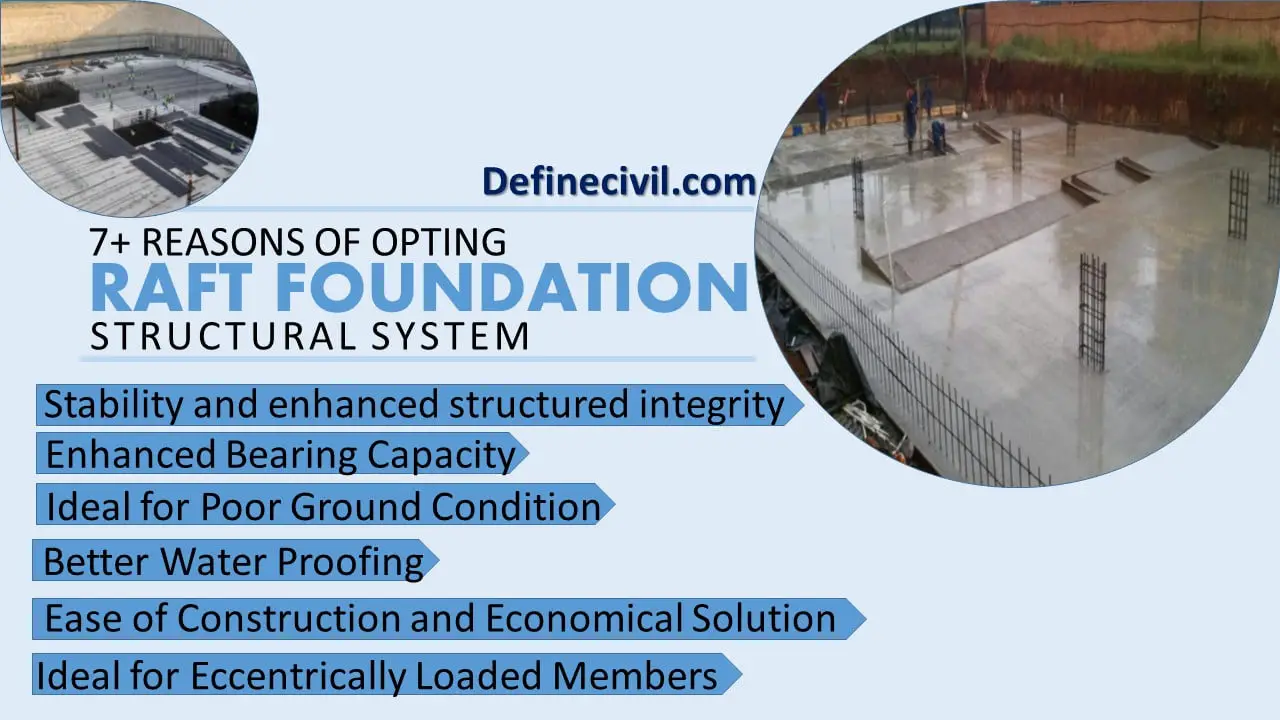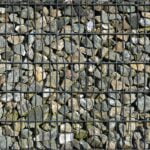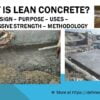Manifold advantages of raft foundation and trifling disadvantages of mat foundation are the two basic reasons for increased usage and opting of raft foundation aka mat foundation.
So in this read I will be going to explain in-depth the various benefits of raft foundation.
Raft foundation which is also sometimes termed as mat foundation is a reinforced concrete slab covering the entire foundation area thereby providing supports to all the columns or the walls whatever the structure is supported on.

The raft foundation can be placed directed on the soil or the rock whichever available and otherwise can also be supported on the piles. In case of weak and expansive clays piles must be used for supporting the raft and in that case it is termed as piled raft foundation.
Advantages of Raft Foundation
The following are the benefits of using raft foundation:
-
Stability and enhanced structured integrity
By the use of raft foundation, all the columns are bound at the same level and with the same slab thus creating a rigid and monolithic connection. The columns would be more stable and because of this the differential settlement will be easily avoided because of slab action of the raft foundation.
-
Enhanced Bearing Capacity
As by the use of raft foundation, you are actually increasing the bearing area of the foundation, thus the bearing capacity of the foundation would be much more augmented. As the stress produced is inversely related to the area of impact thus the reduced stress would enhance the longevity of the foundation.
As raft foundation bridges over cavities in the underneath soil, it diminishes the chances of differential settlement. A structure is always designed in a way to bear a safe differential settlement but above that critical dangerous stresses would develop that would not be bearable for the structure. Thus raft foundation ensures equal settlement and thus increases the bearable settlement than that if the foundation is built on individual footings.
-
Ideal for poor ground condition
In case your ground conditions are not that good to support the loadings of the structure directly by isolated or pad foundation, so by the raft foundation you can create a brand new bearing area that is of reinforced concrete. So even if you are going to put heavy loads on a single corner of a structure, you can do that easily and without any worry. The engineering advantages of raft foundation like load spreading mechanism makes it an ideal choice for weak grounds.
- Ease of construction and economical solution
If you have 100 columns in a structure and all are on isolated / pad foundation, you have to tie and untie the formwork 100 times that is hours of time wastage. But because of benefits of raft foundation, you can pour the foundation slab in a single go while the reinforcement dowels of the columns would be embedded easily.
As the bearing capacity of the raft foundation is enhanced, the foundation can be placed bit shallow to the ground comparative to pad or isolated foundation. This reduced depth would in turn reduces the quantity of excavation required and thereby saving a lot of bucks in your pocket.
-
Better Water Proofing
Now this is a very promising and unique advantage of raft foundation. At number of times, in case of water lodged areas or where clayey soil is exposed, the structures are prone to damages and reparations. Such damages can be avoided by the use of raft foundation.
Basements located below ground water table should use a mat as their base to provide water tight construction. The alternative of having individual columns footings connected by thin slabs has not proved to be successful in most of the cases; presents difficulties in water proofing, causes concentration of stresses at the junction of the thin slabs and footings and also at the junction of the basement walls and raft causing cracks to develop. This arrangement, therefore, should not be resorted to unless the economy is of such a magnitude as to outweigh all other considerations.
-
Ideal for eccentrically loaded members
Situations also arise when isolated footings are subjected to very large eccentric loadings, and one is faced with the possibility of excessive footing rotation, excessive differential settlement or possibility of exceeding the allowable bearing capacity of the soil at some location.
This can happen when the building consists of shear walls and columns, shear walls sharing most of the horizontal load subjecting its footings to large settlements and rotation, decreasing the effectiveness of the shear walls and also creating difficulties by way of large differential settlements raft, if provided, will even out these deformations.
Disadvantages of Raft Foundation
I have used the word trifling for disadvantages of raft foundation and the reason behind is that they are never a need to worry on mega projects. Because of the advantages and benefits derived are way more than the glitches and drawbacks.
Anyhow, following are some of the disadvantages of raft foundation:
- The design of raft foundation is more tedious sometimes, as compared with the isolated or pad foundation. The stresses of punching shear and similar ones are to be tackled one to avoid any dangerous or untoward situation.
- In case of heavy concentrated loads on one spot, special reinforcements are to be provided that may cause congestion and/or difficulty in fixing.
- The edges and corners of the raft foundation are weaker and are to be treated before servicing the building.
- The heave and frost actions in some areas may be a slight worry for the contractor while founding a raft foundation.

















